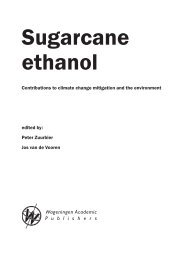Production and use of fuel ethanol in Brazil - BAFF
Production and use of fuel ethanol in Brazil - BAFF
Production and use of fuel ethanol in Brazil - BAFF
You also want an ePaper? Increase the reach of your titles
YUMPU automatically turns print PDFs into web optimized ePapers that Google loves.
environment. Studies conducted <strong>in</strong> <strong>Brazil</strong> by the São Paulo state’s environmental<br />
agency CETESB (www.scielo.br/pdf/rsp/v39n3/en_24804.pdf) with diesel vehicles<br />
show that emissions <strong>of</strong> aldehydes from those vehicles can be up to 40 times as<br />
high as those from vehicles runn<strong>in</strong>g exclusively on <strong>ethanol</strong>. In <strong>Brazil</strong> <strong>and</strong> other<br />
countries aldehyde emissions have been successfully controlled with the help <strong>of</strong><br />
catalytic converters, which for years have been st<strong>and</strong>ard equipment for emission<br />
control.<br />
Air quality surveys <strong>in</strong> regions where <strong>ethanol</strong> has been <strong>in</strong> <strong>use</strong>, either straight or <strong>in</strong><br />
blends with gasol<strong>in</strong>e do not show that the aldehyde emissions result<strong>in</strong>g from the <strong>use</strong><br />
<strong>of</strong> that <strong>fuel</strong> have ca<strong>use</strong>d problems.<br />
B4.3.<br />
Is it true that the <strong>use</strong> <strong>of</strong> <strong>ethanol</strong>-gasol<strong>in</strong>e blends<br />
<strong>in</strong>creases NOx emissions?<br />
The NOx (nitrogen oxides) emissions from a fleet <strong>of</strong> gasol<strong>in</strong>e-<strong>fuel</strong>ed vehicles<br />
can <strong>in</strong>crease slightly when us<strong>in</strong>g gasol<strong>in</strong>e blends with up to 10 percent <strong>ethanol</strong>.<br />
The observed <strong>in</strong>crease is usually around 1 percent, on average. Not only is that<br />
variation <strong>of</strong> little significance, it is also lower than that observed for vehicles that<br />
are converted for runn<strong>in</strong>g on natural gas or equipped with diesel eng<strong>in</strong>es, the <strong>use</strong> <strong>of</strong><br />
which has been promoted as environment-friendly <strong>in</strong> many countries, but the NOx<br />
emissions from which can be more 200 percent higher than those <strong>of</strong> equivalent<br />
vehicles runn<strong>in</strong>g on gasol<strong>in</strong>e.<br />
B4.4.<br />
Does the addition <strong>of</strong> <strong>ethanol</strong> to gasol<strong>in</strong>e ca<strong>use</strong><br />
volatile compound emissions?<br />
Even though <strong>ethanol</strong> is a low-volatility <strong>fuel</strong>, five times less volatile than gasol<strong>in</strong>e,<br />
it has the effect <strong>of</strong> <strong>in</strong>creas<strong>in</strong>g volatility <strong>in</strong> the blend with gasol<strong>in</strong>e. The magnitude<br />
<strong>of</strong> the <strong>in</strong>crease <strong>in</strong> such emission basically depends on the <strong>ethanol</strong> content <strong>of</strong> the<br />
blend <strong>and</strong> the gasol<strong>in</strong>e composition. This characteristic, which can actually be<br />
positive <strong>in</strong> temperate zones beca<strong>use</strong> it makes cold starts easier, has been the<br />
subject <strong>of</strong> a lot <strong>of</strong> discussion due to the allegation that favors the permeability <strong>of</strong><br />
the <strong>fuel</strong> <strong>in</strong>to components made from some types <strong>of</strong> rubber <strong>and</strong> plastic, result<strong>in</strong>g<br />
<strong>in</strong> <strong>in</strong>creased volatile compound emissions. It is important to note that this effect<br />
can be m<strong>in</strong>imized by adjust<strong>in</strong>g the gasol<strong>in</strong>e composition for the <strong>in</strong>tended <strong>ethanol</strong><br />
content <strong>of</strong> the blend.<br />
B. Sugar-cane <strong>and</strong> <strong>ethanol</strong> production: environmental aspects<br />
53












